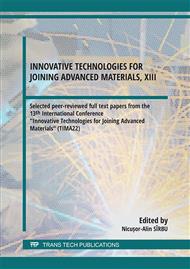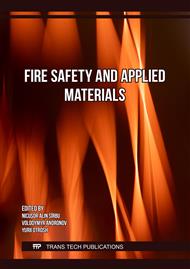[1]
M.Y. Khan, P.S. Rao, and B.S. Pabla: A Framework for Surface Modification by Electrical Discharge Coating using Variable Density Electrodes, 3rd International Conference on Design and Manufacturing Aspects for Sustainable Energy (ICMED-ICMPC 2021), Vol. 309 (2021)
DOI: 10.1051/e3sconf/202130901093
Google Scholar
[2]
S. Kumari: Study of TiC coating on different type steel by electro discharge coating, M.Tech. dissertation, National Institute of Technol, Rourkela (2015)
Google Scholar
[3]
D.S. Verma: A study on Surface modification of Aluminium Al6061 using electric discharge coating, M.E. Dissertation, National Institute of Technical Teachers' Training and Research, Chandigarh (2017)
Google Scholar
[4]
S. Chakraborty, S. Kar, V. Dey and S.K. Ghosh: The phenomenon of surface modification by electro-discharge coating process: a review, Surface Review and LettersVol. 25, No. 01, (2018)
DOI: 10.1142/s0218625x18300034
Google Scholar
[5]
Viet D. Bui, James W. Mwangi, Ann-Kathrin Meinshausen, Andreas J. Mueller, Jessica Bertrand and Andreas Schubert, Antibacterial coating of Ti-6Al-4V surfaces using silver nano-powder mixed electrical discharge machining, Surface and Coatings Technology, Volume 383, (2020)
DOI: 10.1016/j.surfcoat.2019.125254
Google Scholar
[6]
R. Bröcking, A. Meghwal, S. Melzer, S. Verdier, G. Evans, T. Lowbridge, J.F. Vanhumbeeck, D. Debrabandere and J. Crahay: Development of electrical discharge coating (EDC) as chrome-free alternative for increasing campaign length of temper mill work rolls, Iron Steel Technol, 12, 68 (2015)
Google Scholar
[7]
R., Rajeshshyam, R. Venkatraman and S. Raghuraman: Process Optimisation and Tribological Behaviour Studies on Surface Modified Al 6061-T6 Alloy Deposited with WS2 Solid Lubricant Layer Through Electrical Discharge Approach, Arabian Journal for Science and Engineering 47, 8009–8030 (2022)
DOI: 10.1007/s13369-021-05908-w
Google Scholar
[8]
U. Elaiyarasan, B. Vinod and K. Nallathambi: Response surface methodology study on electrical discharge deposition of AZ31B magnesium alloy with powder composite electrode International Journal on Interactive Design and Manufacturing (IJIDeM) (2022)
DOI: 10.1007/s12008-022-00923-z
Google Scholar
[9]
Christoglou, Ch. et al.: Deposition of Aluminium on Magnesium by a CVD Process, Surface and Coatings Technology 184.2-3, p.149–155 (2004)
DOI: 10.1016/j.surfcoat.2003.10.065
Google Scholar
[10]
I. O. Klimenko, V. G. Marinin, M. A. Bortnitskaya and S. Kuprin: Cavitation and erosion resistance of vacuum arc Ti, Ti-Al, Ti-Zr, and Ti-Ni coatings, Problems of atomic science and technology, September, pp.38-42 (2022)
DOI: 10.46813/2022-140-038
Google Scholar
[11]
T.H. Duong, H. M. Hoang and H. C. Kim: An investigation of electrical nickel deposition on copper nanowires-based electrodes, Chemical Engineering Communications, 207:5, 652-664 (2020)
DOI: 10.1080/00986445.2019.1613232
Google Scholar
[12]
B. R. Tzaneva, S. K. Andreev, A. S. Zahariev and K. G. Ruskova: Effect of Electroless Nickel Deposition on the Breakdown Voltage of Nanoporous Aluminium Oxide, IEEE XXVII International Scientific Conference Electronics - ET, pp.1-4 (2018)
DOI: 10.1109/et.2018.8549625
Google Scholar
[13]
D. Ghiculescu: Ultrasonically Aided Electrical Discharge Machining, in Electrical Discharge Machining (EDM), Types, Technologies and Applications, Editor, Jahan, M.P., Nova Publishers, New York, USA (2015)
Google Scholar
[14]
B. Murlidharan, H. Chelladurai and R. Janakarajan: Experimental Investigation on Electro-Discharge Deposition Process, The International Journal of Advanced Manufacturing Technology, Vol. 76, p.69–82 (2015)
Google Scholar



